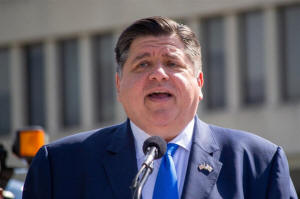State ends fiscal year with record $50.7 billion in base revenue,
sparking small surplus
 Send a link to a friend
Send a link to a friend
[July 08, 2023]
By JERRY NOWICKI
Capitol News Illinois
jnowicki@capitolnewsillinois.com
 State revenues once again reached a record high in the fiscal year that
ended June 30, creating what Gov. JB Pritzker called a “one-time” budget
surplus of over $700 million. State revenues once again reached a record high in the fiscal year that
ended June 30, creating what Gov. JB Pritzker called a “one-time” budget
surplus of over $700 million.
The $50.7 billion in base general revenues that the state collected in
fiscal year 2023 – which exclude one-time pandemic-related federal funds
– topped last year’s previous record by $373 million.
That’s $726 million beyond what was projected by the Governor’s Office
of Management and Budget in its most recent estimate adopted in May
during negotiations for the fiscal year 2024 budget.
“It’s always good to have a surplus, and that's something that we've
done consistently now for four years,” Pritzker said at an unrelated
Friday news conference. “I would add that much of the surplus that we
saw that came in at the end of the year is one-time dollars.”
In recent years, the state has dedicated surpluses to paying down long-
and short-term debt, making pension payments beyond the amounts required
in law and providing one-time temporary tax relief.
Pritzker indicated he’d continue to be cautious when considering
spending priorities for one-time revenues, echoing his budget office,
which noted that revenues have fluctuated wildly from month to month in
recent years.
“This is a kind of an unexpected additional amount of money,” Pritzker
said. “We're going to try to apply it to things like paying down debt,
the things that we've been doing.”

A cushion for 2024
The surplus creates some breathing room one week into a $50.4 billion
state spending plan for fiscal year 2024 that anticipates a slimmer
surplus of $183 million.
"The overperformance in FY 2023 revenues essentially translated into a
lower than projected June 30 bills on hold at the (comptroller’s office)
and higher than expected cash balances going into the new fiscal year,"
Carol Knowles, a spokesperson for GOMB, said in a statement prior to the
governor's comments. "We will continue to monitor the revenue
performance in FY 2024 as the national economy continues to have mixed
economic projections."
Comptroller Susana Mendoza’s office noted the state entered the year
with over $1 billion in its general revenue fund and an accounts payable
balance of just over $500 million, meaning bills are paid within a week
of being sent to Mendoza’s office. The balance of the state’s “rainy
day” fund sits at nearly $2 billion.
It’s a drastic departure from 2017, when a state budget impasse between
Republican Gov. Bruce Rauner and Democrats in the General Assembly drove
the state’s backlog of unpaid bills to nearly $17 billion and depleted
the rainy day fund to less than $60,000.
“All this good fiscal news did not happen by accident,” Mendoza said in
a statement. “This takes strong strategic planning throughout the year
and daily attention to cash management; knowing which bills to pay first
to maximize federal matching funds so we can end the fiscal year on such
a high note.”
Pritzker said Friday that getting bills out the door within three to
five days might be “too fast” a turnaround, since they are being paid
days to weeks before late-payment interest begins accruing.
“We could be earning interest on the money and wouldn't be paying
interest on that if you just extended it for a few more days,” he said.
“But meanwhile, I think we should all celebrate the fact that Illinois
is in such good fiscal shape.”
The General Assembly’s Commission on Government Forecasting and
Accountability – a bipartisan body staffed by nonpartisan economic
analysts – noted in its June report that state coffers accumulated $407
million in interest in FY 2023. That’s up from just $30 million in
interest in FY 2022, a result of several interest rate hikes by the
Federal Reserve.
FY 2023’s revenues were also bolstered by a $1.2 billion transfer into
the general revenue fund from the state’s income tax refund fund. The
amount of that annual statutory transfer was driven upward by strong
income tax receipts from the prior fiscal year and is unlikely to be
replicated in FY 2024.
Despite setting a new base revenue record, FY 2023 saw a $1.3 billion
drop-off in personal income tax receipts compared to the previous fiscal
year. Corporate income tax and sales tax revenues, however, spiked by a
combined $1.1 billion.
[to top of second column]
|

Gov. JB Pritzker speaks at a news
conference in Springfield Friday. (Capitol News Illinois photo by
Jerry Nowicki)

The COGFA report noted that the personal income tax decline “is believed
to be more reflective of exceptional tax performance in FY 2022… rather
than a weakening of Illinois’ tax base.”
Conservative estimates exceeded
FY 2023 marked the second consecutive year in which state revenues
exceeded initial estimates by billions of dollars. FY 2022’s base
revenues of $50.3 billion – again, a number that excludes federal
pandemic aid – topped that year’s initial estimate by nearly $8 billion.
Despite the record revenue performance of FY 2022, lawmakers ultimately
approved a $46.4 billion budget plan that anticipated an 8 percent
decline in base revenues in FY 2023.
That was, in part, a response to ongoing concerns of a recession, which
COGFA noted lingered throughout FY 2023 but did not materialize.
Instead, revenues grew by a little less than 1 percent, driven by a
continued strong performance in the first eight months of the fiscal
year. Through February, each month of FY 2023 exceeded revenues of the
prior year.
That led lawmakers to pass multiple supplemental spending plans
throughout the fiscal year, dedicating about $2.7 billion to retiring
long-term debt while supplementing the state’s Medicaid program,
bolstering pension payments and creating a “closing fund” to lure
businesses to the state among other measures.
The fiscal picture got murkier in April, however, as revenues plummeted
by $1.8 billion from the year prior, leading GOMB to estimate just less
than $50 billion in end-of-year revenues as lawmakers finalized a budget
plan.
May revenues rebounded, however, in part because the month had an extra
weekday to process tax payments compared to the year prior, while April
had one fewer.
June came in slightly behind the same month in FY 2022, but COGFA noted
that, too, was “mainly the result of the timing of receipts…rather than
a declining trend in taxable income.”
Employment and wage levels in June, the report added, “continue to show
year-over-year improvement.”
Still, COGFA’s report noted that “many economic forecasters still have a
recession in the short-term as a distinct possibility.” It also noted
the investment bank Goldman Sachs reduced its projected odds of the U.S.
economy entering a recession in the next 12 months to 25 percent from 35
percent.
The governor’s office has noted its FY 2024 budget, which plans for
$50.6 billion in revenue, anticipates a “mild recession.”
Federal stimulus
The FY 2023 revenue figures jump to $53.1 billion when including federal
dollars.
That’s due in part to an accounting measure that switched the funding
source of about $1.7 billion in one-time pandemic-driven programs – such
as infrastructure and grant programs – from federal stimulus funds to
general revenue funds. Federal stimulus funds that had been earmarked
for those projects will instead be redirected to other qualifying state
expenditures, freeing up the general funds.

The move – which has no net effect on available state finances – was
proposed by the governor and approved by lawmakers to ensure the state
“fully expends” its COVID-19 recovery funds “within the allowed
timeframe set by the federal government,” according to GOMB.
The governor’s office said the move ensures all commitments of pandemic
stimulus funds are honored while providing a cleaner reporting process
to the federal government, particularly for projects that have
multi-year timelines for completion.
Capitol News Illinois is a nonprofit, nonpartisan news
service covering state government. It is distributed to hundreds of
print and broadcast outlets statewide. It is funded primarily by the
Illinois Press Foundation and the Robert R. McCormick Foundation, along
with major contributions from the Illinois Broadcasters Foundation and
Southern Illinois Editorial Association. |